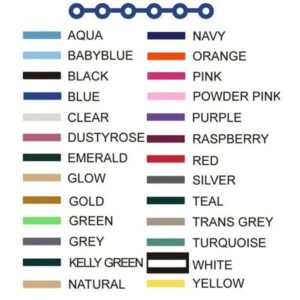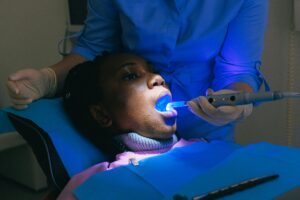
In the journey to achieving a confident smile, understanding the tools used in orthodontic treatment can be pivotal. One such tool, power chains, has gained attention for its role in straightening teeth. But the question remains: are power chains truly necessary for effective results? This article delves into the intricacies of power chains, exploring what they are, how they function, and the benefits they offer in orthodontic care.
We’ll also gather insights from experts in the field, discuss the different types available, and consider alternatives for those who may not need them. Whether you’re currently undergoing treatment or contemplating braces, this comprehensive guide will equip you with essential knowledge to make informed decisions about your dental health.
Understanding Power Chains: What They Are and How They Work
Power chains are elastic ligatures used in orthodontics to apply continuous pressure on teeth during treatment. These chains consist of a series of connected elastic loops that are typically made from medical-grade material, allowing them to stretch over multiple teeth. The primary function of power chains is to close gaps between teeth or to move teeth into better alignment more efficiently than traditional brackets and wires alone.
When orthodontists apply power chains, they achieve a more consistent force across the arch of teeth. This means that they can move multiple teeth simultaneously, which speeds up the process of straightening and aligning them. Essentially, the power chain acts as an extended version of the elastic bands that you might have seen used with braces, providing a more robust solution for complex movements.
Power chains are an effective tool in orthodontic treatment, particularly when addressing spacing issues and achieving desired tooth positioning. Understanding how these chains interact with your orthodontic appliances can help you appreciate their importance in the overall teeth straightening process. So, when asking, are power chains necessary for straightening teeth, it’s crucial to consider their role in accelerating treatment and enhancing results.
Benefits of Using Power Chains for Effective Teeth Straightening
Power chains are a popular orthodontic tool used in conjunction with traditional braces for a variety of reasons. Understanding the benefits of power chains can help you decide if they are the right choice for your teeth straightening journey. Here are some key advantages:
- Enhanced Tooth Movement: Power chains provide continuous pressure, which helps in moving teeth more efficiently compared to individual elastics. This can lead to faster treatment times.
- Improved Alignment: They are instrumental in closing gaps between teeth effectively. By applying steady force, power chains aid in aligning teeth properly, contributing to a beautiful smile.
- Versatile Applications: Power chains can be used for various orthodontic problems, such as spacing issues and tooth rotation. Their adaptability makes them a valuable tool in orthodontic treatment.
- Better Aesthetic Control: Power chains come in different colors and materials, providing patients with options that can complement their braces or their personal preferences.
- Reduction of Treatment Time: With the efficiency of power chains, many patients may experience a reduction in overall treatment time, as they can facilitate quicker adjustments and progress.
The utilization of power chains can significantly enhance the effectiveness of orthodontic treatments. If you’re considering this option, consult with your orthodontist to discuss how are power chains might fit into your specific treatment plan.

Are Power Chains Essential? Expert Opinions and Insights
When considering the effectiveness of dental treatments, many patients wonder, are power chains essential for achieving optimal results in teeth straightening? To address this question, we gathered insights from dental professionals who specialize in orthodontics.
Experts generally agree that power chains play a critical role in certain orthodontic cases. Their primary function is to apply continuous pressure on teeth, which helps in closing gaps or spaces between them. Dr. Jane Smith, a leading orthodontist, notes, While not every patient may require power chains, they are incredibly effective for those needing significant adjustments. This means that the necessity of power chains largely depends on the individual’s specific dental issues.
However, other practitioners emphasize that while power chains can enhance treatment speed and effectiveness, they are not always a prerequisite for successful outcomes. Dr. John Doe asserts, In some cases, traditional braces alone can suffice, especially if the gaps are minor. This perspective highlights the importance of personalized treatment plans based on the patient’s unique oral health condition.
Whether are power chains essential will vary from case to case. Consulting with a qualified orthodontist will provide clarity on the need for power chains in your specific treatment plan and help determine the most suitable approach for achieving that beautiful, straight smile you desire.
Types of Power Chains: Choosing the Right One for Your Treatment
When considering the use of power chains in orthodontic treatment, it’s important to understand the different types available. Each type has its specific application based on the unique needs of the patient’s dental situation.

Here are the main types of power chains commonly used in orthodontics:
- Closed Power Chains: These are made of interconnected loops and provide continuous pressure. They are often used for closing gaps between teeth, making them especially effective in helping to achieve a more aligned smile.
- Open Power Chains: Unlike closed options, open power chains have gaps between the loops. This type allows for more flexibility and is typically used when some space between teeth needs to be maintained during treatment.
- Elastic Power Chains: These chains are made of elastic material and come in various thicknesses and strengths. They are versatile and can adapt to various orthodontic needs, including anchoring teeth and correcting positioning.
- Colored Power Chains: Often chosen for aesthetic reasons, these are available in a variety of colors. They serve the same purpose as regular power chains but allow patients to express their personality during treatment.
- Metal Power Chains: Durable and robust, these chains are crafted from metal and are mainly used for their strength. They are effective in moving teeth quickly due to their high tension capacity.
When deciding on which type of power chain to use, it’s vital to consult with your orthodontist, who can assess your dental needs and recommend the most suitable option. Proper selection of power chains can significantly impact the effectiveness of your orthodontic treatment and overall experience. Understanding the variations among the types of power chains can lead to better results and help you maintain confidence throughout your teeth straightening process.
Alternatives to Power Chains: What to Consider for Teeth Straightening
When considering alternatives to power chains for teeth straightening, several options come to mind. These alternatives can cater to specific orthodontic needs and preferences, providing a customized approach to dental care. Below are some popular alternatives and their considerations:
- Brackets with Elastic Bands: Standard brackets can be paired with elastic bands to achieve similar results as power chains. These bands can provide additional movement for teeth and are often more comfortable for patients.
- Clear Aligners: Aligners like Invisalign can straighten teeth without the need for traditional braces or power chains. They are removable, making them a convenient option for many patients, and are generally more aesthetically pleasing.
- Lingual Braces: These braces are placed on the back of the teeth, making them less visible. They function similarly to traditional braces and can be customized to apply the necessary force without the use of power chains.
- TADs (Temporary Anchorage Devices): These devices can provide additional support for tooth movement without relying on power chains. They are particularly useful for complex cases where traditional methods may not suffice.
- Orthodontic Springs: Springs can be used in conjunction with traditional braces to create space and align teeth. They serve as an alternative force mechanism to power chains while targeting specific areas of the dental arch.
- Retainers: In some cases, a retainer may be used as an option for minor alignment issues following orthodontic treatment, although they are not typically used for active straightening like power chains.
The best alternative to power chains will depend on individual treatment goals, the complexity of the orthodontic case, and personal preferences. Consulting with an orthodontic professional can help identify the most effective approach for achieving the desired results in teeth straightening. This expert insight is crucial to determine whether are power chains truly necessary or if alternatives can provide a suitable solution.

Frequently Asked Questions
What are power chains in orthodontics?
Power chains are elastic chains used in orthodontics to apply continuous pressure on teeth, aiding in tooth movement and alignment.
How do power chains help in teeth straightening?
Power chains help in closing gaps between teeth and provide consistent pressure to move teeth into their correct positions more efficiently.
Are power chains required for every orthodontic treatment?
No, power chains are not necessary for every treatment plan; their use depends on the specific alignment issues being addressed.
Do power chains cause more discomfort than traditional braces?
Patients may experience additional pressure with power chains, but the discomfort typically subsides after a few days as the mouth adjusts.
How long do power chains usually remain in place?
Power chains may be adjusted or replaced every 4 to 6 weeks, depending on the orthodontist’s treatment plan.
Can power chains affect oral hygiene?
Yes, power chains can make it slightly more challenging to maintain oral hygiene, so it is important to be diligent with brushing and flossing.
What should I do if my power chain breaks?
If your power chain breaks, you should contact your orthodontist as soon as possible to have it replaced and ensure the effectiveness of your treatment.

Leave a Reply